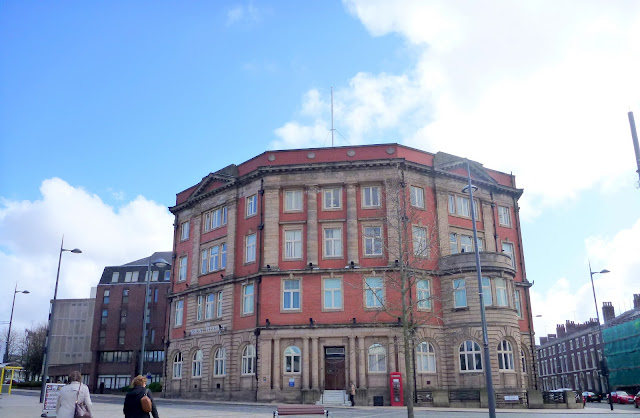Liverpool is a beautiful city, with wonderful architecture, both old and new, a lot of art galleries and museums, and lots to do. I have never seen so many shopping centres in any one city, but we tried to avoid those. We spent two nights there, and left feeling that we had to go back and soon.
The Adelphi Hotel, in Ranelgh Place is the third hotel on the site and has been designated as Grade II listed. In the past, the hotel served as the most popular hotel in the city for wealthy passengers before they embarked on their journey to North America. The hotel's Sefton suite is an exact replica of Titanic's First Class Smoking Lounge - the Titanic was registered in Liverpool though it never visited the port.
It is constructed in Portland stone and has seven stories. The corridors are marble lined, and our room had floor to ceiling oak panelling, with double doors.
The hotel has been featured in a lot of television and film: the lounge was used in the 1981 television series Brideshead Revisited as the interior of an ocean liner. In 1997, the hotel was the subject of an eight-part BBC documentary series, Hotel. The series was voiced, very aptly, by Andrew Sachs, who played Manuel in Faulty Towers. Furthermore, in Jules Verne's novel Twenty Thousand Leagues Under the Sea, Professor Aronnax describes the interior of the submarine as similar to the Adelphi hotel.
Do not be fooled by the grandeur however and consider staying there. It is one of the worst, probably the worst hotel we have ever stayed in. It is filthy, dirt and squalor being the order of the day, the staff are unhelpful to the point of rudeness, and the food unapalatable. There was no heating in our room. Stay away and advise your friends to do the same.
The iconic Lewis's building, also in Ranelagh Place, designed in 1947 by Gerald de Courcy Fraser, and constructed in the late 1940s and early 1950s, replacing an earlier building that was destroyed during WWII. Portland stone facade. Above the main entrace is a statue of a nude man by Jacob Epstein: its official title is Liverpool Resurgent, but is nicknamed 'Dickie Lewis'.
looking closer
and a side view.
The city is full of beautiful buildings
Warehouse and offices at 12 Hanover Street, another grade II Listed building, built in 1889, designed by Edmund Kirby. It is made of soft red brick with terracotta detailing around the windows and chimneys that rise dramatically above a balustrade, a totally theatrical statement.
Opposite the Metropolitan Cathedral of Christ the King.
The University district
Victoria Gallery and Museum
The World Museum, also on William Brown Street, the only street in the UK to consist of nothing other than museums, galleries and libraries.
St John's Gardens, with St George's Hall in the distance
the Gardens again
St George's Hall
Hillsborough Disaster Memorial
grand buildings and massive avenues
Castle Street
The Town Hall
the back of the Town Hall, situated in Exchange Flags square,
a most deligutful square
we liked it so much, we had to stay for a cup of tea at Gourmet Coffee, so as to prolong the pleasure
one of the astonishing things about Liverpool is the variety in the styles of the architecture
like this Art Deco tower
Matthew Street where the Cavern used to be
outside the (new) Cavern pub
where the old Cavern used to be
and then just round the corner, we came upon four of these.
During our last morning in Liverpool we re-visited some of the places we had seen before, and came upon the Mill House, University of Liverpool School of Medicine.
This was built in 1890 as an addition to the Liverpool Royal Infirmary Hospital and Lunatic Asylum and served as a working hospital throughout the two world wars and eventually closed in 1978.
Oriel Chanbers, on Water Street, designed by Peter Ellis and built in 1864, it is the world's first building featuring a metal framed glass curtain wall. It remains one of the finest and most influential buildings of its age. It is one of the first office buildings to use an iron framework structure, and its innovative design had a considerable influence on office buildings across the world, particularly the early skyscrapers in Chicago and New York. It was not received well initially, and was described as a 'monstrous agglomeration of protruding plate glass bubbles' amongst other things. Due to this antagonism, Peter Ellis only ever designed one other building.
Nikolaus Pevsner described it like this: 'the delicacy of the ironwork in the plate-glass oriel windows and the curtain walling at the back with the vertical supports retracted yet visible from outside is almost unbelievably ahead of its time.'
16 Cook Street, the only other building that Peter Ellis designed.
Back on Water Street, another remarkable building, The Tower Building, designed by Walter Aubrey Thomas, is opposite the Royal Liver Building on the Strand, and extends round the corner into Water Street. It is constructed on a steel frame, clad in grey granite, and faced with white glazed terracotta made by Doulton. A balustrade runs along the top of the building. At the corners of the towers are castellated turrets.











































A popular meeting place is the front of Lewis' underneath Epstein's statue. With typical Scouse humour people would say, when arranging the rendezvous, "meet you under the balls"
ReplyDeleteHahaha! very appropriate.
DeleteI loved that building, but then, there is so much to love and admire in Liverpool.
A wonderful tour of a fantastic city.
ReplyDeleteThanks Ken.
Delete